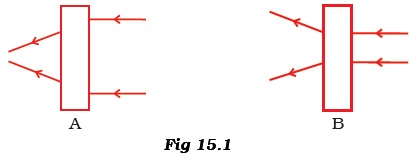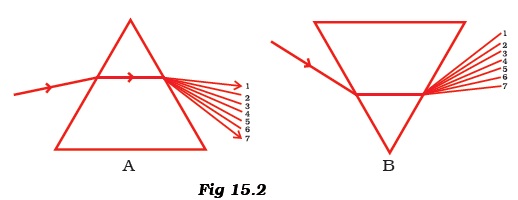Class 7 Important Questions for Science – Light
NCERT Exemplar Class 7 Science is very important resource for students preparing for VII Board Examination. Here we have provided NCERT Exemplar Problems Solutions along with NCERT Exemplar Problems Class 7.
Question from very important topics are covered by NCERT Exemplar Class 7. You also get idea about the type of questions and method to answer in your Class 7th examination.
Here you can get Class 7 Important Questions Science based on NCERT Text book for Class VII. Science Class 7 Important Questions are very helpful to score high marks in board exams. Here we have covered Important Questions on Light for Class 7 Science subject.
Science Important Questions Class 7 are given below.
Multiple Choice Questions
- Boojho and Paheli were given one mirror each by their teacher. Boojho found his image to be erect and of the same size whereas Paheli found her image erect and smaller in size. This means that the mirrors of Boojho and Paheli are, respectively
- (a) plane mirror and concave mirror.
- (b) concave mirror and convex mirror.
- (c) plane mirror and convex mirror.
- (d) convex mirror and plane mirror.
- Which of the following can be used to form a real image?
- (a) Concave mirror only.
- (b) Plane mirror only.
- (c) Convex mirror only.
- (d) Both concave and convex mirrors.
- If an object is placed at a distance of 0.5 m in front of a plane mirror, the distance between the object and the image formed by the mirror will be
- (a) 2 m
- (b) 1 m
- (c) 0.5 m
- (d) 0.25 m
- You are provided with a concave mirror, a convex mirror, a concave lens and a convex lens. To obtain an enlarged image of an object you can use either
- (a) concave mirror or convex mirror.
- (b) concave mirror or convex lens.
- (c) concave mirror or concave lens.
- (d) concave lens or convex lens.
- A rainbow can be seen in the sky
- (a) when the sun is in front of you.
- (b) when the sun is behind you.
- (c) when the sun is overhead.
- (d) only at the time of sun rise.
- An erect and enlarged image can be formed by
- (a) only a convex mirror.
- (b) only a concave mirror.
- (c) only a plane mirror.
- (d) both convex and concave mirrors.
- You are provided with a convex mirror, a concave mirror, a convex lens and a concave lens. You can get an inverted image from
- (a) both concave lens and convex lens.
- (b) both concave mirror and convex mirror.
- (c) both concave mirror and convex lens.
- (d) both convex mirror and concave lens.
- An image formed by a lens is erect. Such an image could be formed by a
- (a) convex lens provided the image is smaller than object.
- (b) concave lens provided the image is smaller than object.
- (c) concave lens provided the image is larger than object.
- (d) concave lens provided the image is of the same size.
Very Short Answer Type Questions
- The image formed by a lens is always virtual, erect and smaller in size for an object kept at different positions in front of it. Identify the nature of the lens.
- Fill in the blanks:
- (a) The inner surface of a steel spoon acts as a ___________ mirror.
- (b) The outer surface of a flat steel plate acts as a ___________ mirror.
- (c) The outer shining surface of a round bottom steel bowl acts as a __________ mirror.
- (d) The inner surface of the reflector of a torch acts as a __________ mirror.
- State whether the following statements are True or False.
- (a) A concave lens can be used to produce an enlarged and erect image.
- (b) A convex lens always produces a real image.
- (c) The sides of an object and its image formed by a concave mirror are always interchanged.
- (d) An object can be seen only if it emits light.
Short Answer Type Questions
- What type of mirror is used as a side mirror in a scooter? Why is this type of mirror chosen?
- Observe the figures given as Figure 15.1 carefully.

The given figures show the path of light through lenses of two different types, represented by rectangular boxes A and B. What is the nature of lenses A and B? - Boojho made light from a laser torch to fall on a prism. Will he be able to observe a band of seven colours? Explain with a reason.
- State the correct sequence (1-7) of colours in the spectrum formed by the prisms A and B, shown in Figure 15.2.

- The side mirror of a scooter got broken. The mechanic replaced it with a plane mirror. Mention any inconvenience that the driver of the scooter will face while using it?
- The concave reflecting surface of a torch got rusted. What effect would this have on the beam of light from the torch?
- An erect and enlarged image of an object is formed on a screen. Explain how this could be possible.
- Two different type of lenses are placed on a sheet of newspaper. How will you identify them without touching?
- A shopkeeper wanted to fix a mirror which will give a maximum view of his shop. What type of mirror should he use? Give reason.
- The distance between an object and a convex lens is changing. It is noticed that the size of the image formed on a screen is decreasing. Is the object moving in a direction towards the lens or away from it?
Long Answer Type Questions
- Suppose we wish to obtain the real image of a distant tree. Explain two possible ways in which we can do it.
- It was observed that when the distance between an object and a lens decreases, the size of the image increases. What is the nature of this lens? If you keep on decreasing the distance between the object and the lens, will you still able to obtain the image on the screen? Explain.
- You are given three mirrors of different types. How will you identify each one of them?
| « Previous | Next » |
Answers to Multiple Choice Questions
| 1. (c) | 2. (a) | 3. (b) | 4. (b) |
| 5. (b) | 6. (b) | 7. (c) | 8. (b) |
Class 7 Important Questions for Science all topics
Science Important Questions Class 7 are given below chapter wise.
- Nutrition in Plants
- Nutrition in Animals
- Fibre to Fabric
- Heat
- Acids, Bases and Salts
- Physical and Chemical Changes
- Weather, Climate and Adaptation Of Animals to Climate
- Wind, Storm and Cyclone
- Soil
- Respiration in Organisms
- Transportation in Animals and Plants
- Reproduction in Plants
- Motion and Time
- Electric Current and Its Effects
- Light
- Water : A Precious Resource
- Forests : Our Lifeline
- Wastewater Story
Other Study Material
To get study material, exam alerts and news, join our Whatsapp Channel.

